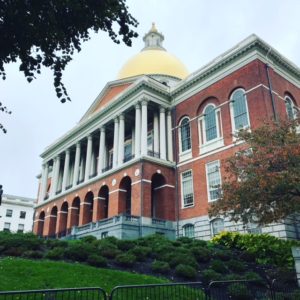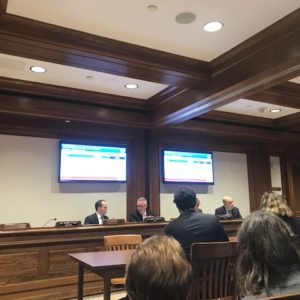On Monday, November 6, the SouthCoast Energy Challenge Program Coordinator, Nicole Morris-McLaughlin, testified at the Massachusetts Statehouse in support of the Benson/Pacheco bill on Local Energy Investment and Infrastructure Modernization (House bill 1725 & Senate bill 1875).
The bills would build a resilient, reliable energy system-one that will not burden poor households but instead one that will provide more consumer control, community input and embrace new and emerging technologies that attain steep reductions in emissions of greenhouse gases.
The text of her testimony can be read below.
I appreciate the opportunity to speak with you today. My name is Nicole Morris-McLaughlin, I work for the Marion Institute’s SouthCoast Energy Challenge. We advocate for Low-Moderate Income households to have access to Energy Efficiency and Clean, Renewable, Affordable Energy Sources on the SouthCoast of Massachusetts.
Massachusetts is at a crossroads as it faces decisions over how to upgrade and expand its energy infrastructure. The energy investment choices that are made today will determine whether we build a resilient, reliable energy system-one that will not burden poor households that makes them look for low rate energy companies to continue being able to heat their homes, but instead, one that will provide more consumer control, community input and embrace new and emerging technologies that attain steep reductions in emissions of greenhouse gases and prices.
In the current system, poorer households suffer a disproportionate Energy Burden. Research shows that poorer households tend to be more conservative energy consumers. Even with this positive behavioral habit they face an uphill battle in being able to afford their energy bills. Poorer households tend to live in less energy-efficient homes, especially in older cities. The SouthCoast Energy Challenge works to sign up these households for Energy-efficiency assessments but can only get so far in the process if there are no incentives for landlords to make their rentals Energy-efficient. Private landlords, especially those who rent to low-income tenants, often have leases in which the tenants pay all direct energy costs. However, energy efficiency in a rental unit is derived by the infrastructure of the unit (windows, caulking, appliances, furnaces, insulation, etc.). The infrastructure is owned and paid for by the landlord who has no incentive to pursue energy savings because those savings would go to the tenant. Landlords could be incentivized to pursue infrastructure improvements through the use of property management solutions like Axxerion which can encourage the landlord to make these improvements as a form of asset management.
In addition, language barriers keep a good amount of our Low-Moderate Income households from being able to access Energy-efficiency programs. If these households happen to get through the difficult hurdles of making their homes as Energy-efficient as can be, they still do not see much relief on their energy bills due to the fact that fixed charges from the Energy companies make up close to half of their bill.
Both Eversource and National Grid have recently proposed increased fixed charges; this would be nothing short of devastating to Low Income households. With energy costs increasingly on the rise, low-income families are often left to make hard choices about whether to spend their money on food or energy.
Today, we are supporting HB 1725/S1875 (the Benson/Pacheco bill on Local Energy Investment and Infrastructure Modernization). In particular we support:
In Section 1: The Low Income specific protections in the grid modernization, such as; remote shutoff protection, restrictions and conditions on pre-paid service, service limiters and other ways around the shutoff protection rules, and protection from special cost recovery mechanisms. This would help low income customers by making sure that their light and power (and critical medical equipment and other things that are not luxuries) cannot be turned off without appropriate procedures, even as we move towards Advanced Metering Infrastructure that can be used in such ways.
In Sections 2-4: Local Energy Resource Alternatives – making it easier and more likely for local energy resources (renewable energy, energy efficiency, demand response, storage, etc) to be able to compete with expensive distribution infrastructure. The fastest growing portion of New England’s electric bills in recent decades has been because of transmission and distribution infrastructure. Harnessing new technologies (especially if they are carbon-free) will save ratepayers money and improve health in the vulnerable communities that typically are located close to polluting sources of energy.
In Section 5: Putting a cap on fixed charges to the cost of connecting the customer and not throwing in grid modernization costs as a fixed charge.
A “Renewable-Ready” energy system can meet our needs today and build the clean, electrified energy system of tomorrow. Provisions to protect the most vulnerable and make sure they do not take on any more burdens with paying for a system that does not benefit them equally and that they do not have power over, is essential. Many of these investments will have immediate economic and environmental benefits that will increase in the future. Starting now will put Massachusetts on the cutting edge to reap the benefits of future breakthroughs in clean generation technology. State and regional leadership will be a national model for bold steps toward a strong economy and a secure energy future.
Your decision to approve or reject the re-visioning of our energy system decides whether we give greater control to customers, keep consumer dollars in our communities, improve system reliability, lower energy costs; create new job markets and dramatically reduce greenhouse gases and other air and water pollutants.












